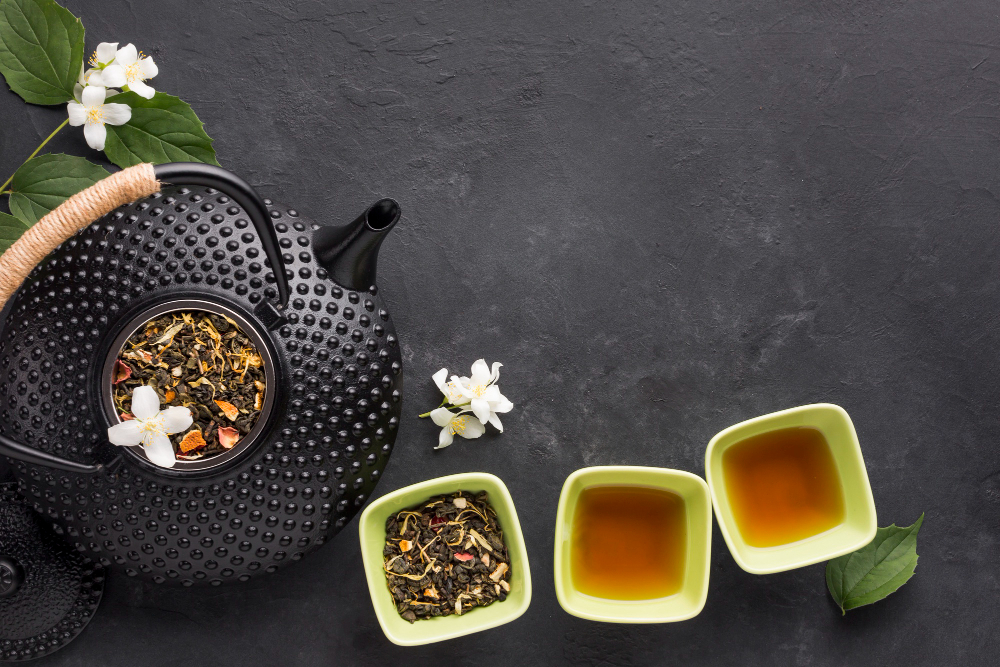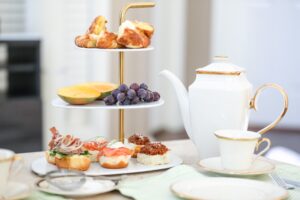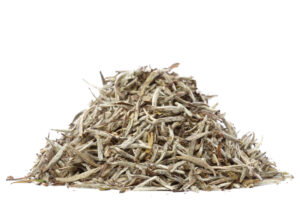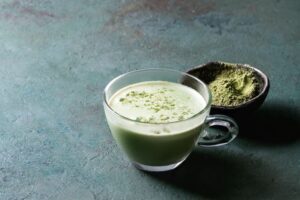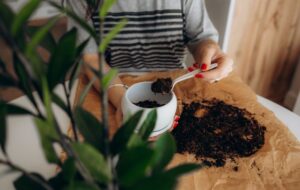Jasmine is green tea with a twist (although black and white tea are sometimes infused with Jasmine), with its own history, and its own delicate flavor, and distinctive aroma. If you’ve never tried it, think about inhaling the scent of a blooming flower garden.
If you knocked on a door in northern China, it would not be unusual to be greeted with a cup of steaming of the best Jasmine green tea, or as it is known in Chinese, “molihua cha”, or “xian pain”. It is perhaps less well-known to households of the western world, where the usual offering (excluding, of course, the bottomless cupboards of the tea lovers and fanatics among us), is a standard black, or maybe, if you’re lucky, a regular old green.
This unassuming tea was once only served to royalty but is now enjoyed all over the world. In this article, we’ll look at the history and background of this gorgeous floral tea before recommending six of the best to try.
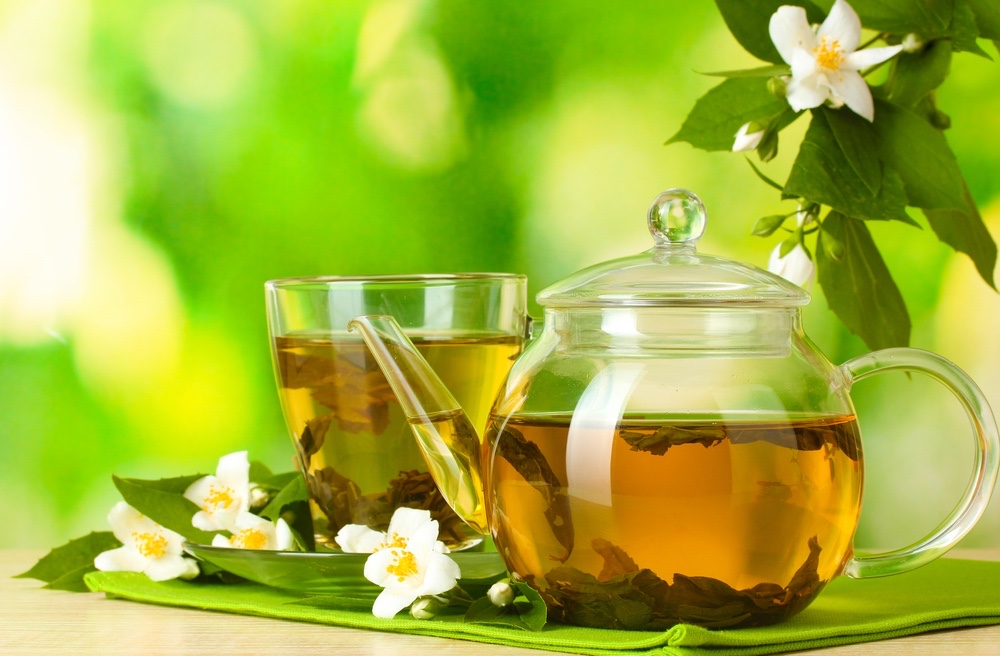
When and Where Did Jasmine Tea Come From?
While the production of the tea is not exclusive to China, it does lay claim as the site of its oldest production, the Jasmine plant was introduced into China during the Han Dynasty (206 BC to 220 AD), and the tea itself became widespread through China in the Qing Dynasty (1644 to 1912 AD).
With its mild climate, abundant rainfall, and close proximity to rivers and mountains, the city of Fuzhou, in China, became the perfect place for the production of Jasmine tea.
While the Jasmine bushes could flourish close to the rivers, the tea plants required elevation, and so covered the slopes of Fuzhou’s surrounding mountains.
The entire cycle of production could be completed in this one city (the only city to boast this), and so it came to be known, delightfully, as “The City of Jasmine in China”.
It has now become one of the most famous scented teas in China.
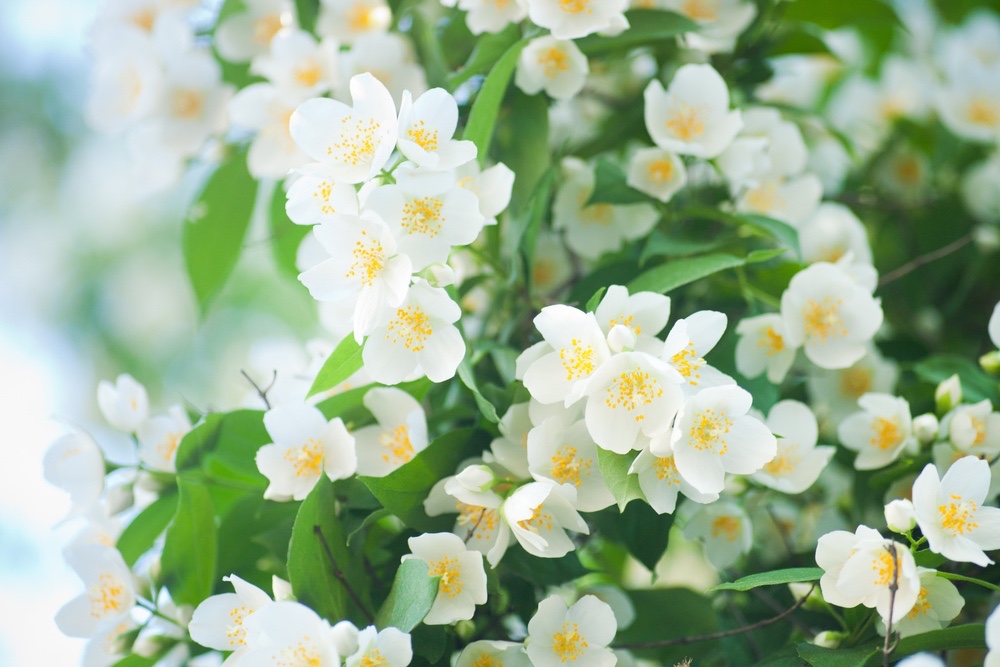
How Does Jasmine Green Tea Differ From Regular Green Tea?
Jasmine tea is basically a scented green tea, its leaves picked from the same tea plant as green or black tea.
Unlike regular green tea, however, as its name suggests it is infused with the blossoms of the Jasmine bush (or Jasminum, in the same family as olive trees), gorgeous little pinwheel flowers which produce a sweet, intoxicating scent. The species mostly used for creating this tea are Jasminum officinale or common jasmine and Jasminum sambac, known as the Sampaguita.
The process of production is precise and quite charming; as the tea leaves are harvested in early spring, they must be stored until late summer, when the fresh Jasmine flowers are in full bloom.
But the flowers of the Jasmine bush can’t be picked at any old time of day – it must be early morning when the white buds are still tightly closed.
Once collected, the flowers are kept cool until nightfall when they begin to uncurl and release their sweet fragrance. And so (this romantic-sounding tea living up to its name), the flowers begin their process of “scenting” in the mysterious death of night.
Two main methods are used to “scent” the tea with the blossom.
The first requires placing the tea and flowers in alternating layers, and the second involves blending the tea with the Jasmine flowers and storing them overnight.
It takes more than 4 hours for the tea to properly absorb the fragrance and flavor of the blossoms, and for top-grade teas such as Yin Hao (meaning “silver tip”), this scenting process may be repeated as many as six or seven times.
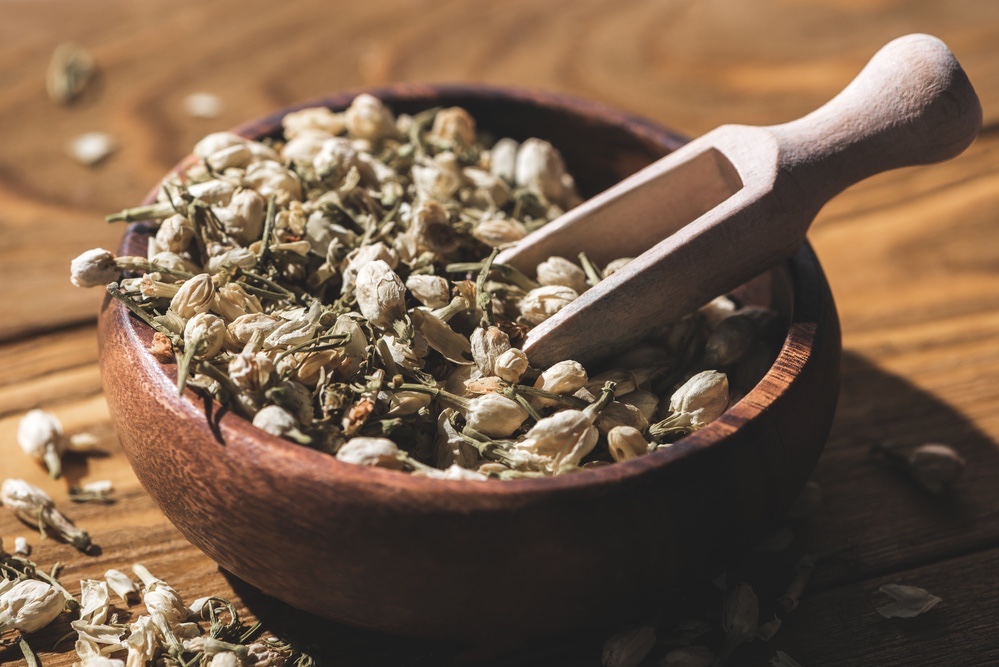
Types of Jasmine Tea
Before we get into some of the best on offer, it may be helpful to know a little more about the different kinds and “grades”.
While the most common are made from green tea leaves, Jasmine blossoms can also be infused with white tea, black tea or oolong tea.
These variations may be simply Jasmine flavored teas, or more elaborate blends, such as “dessert” teas.
If Jasmine tea is the princess of tea (as I like to think of it!), then Jasmine’s “dragon pearls” tea from the city of Fuan, China, is undoubtedly the queen.
This masterful tea is made of tiny hand-rolled “pearls”, and comprised of two sets of buds, and often a green tea leaf.
While the dragon pearl tea may be an expensive option, if you love Jasmine, it’s definitely worth it.
On the other end of the spectrum (the queen’s underlings), are the common loose leafs, the best of which – the top graders – are made with a large ratio of tea buds to tea leaves, producing a subtler and more delicate flavor than teas made with larger leaves and fewer buds.
High-quality teas also infuse with the whole Jasmine blossom, so be suspicious if there’s no sign of flowers in your tea leaves.
How to Make and Enjoy a Cup of Jasmine Tea
A good quality, properly steeped Jasmine should be light and clean, and its aroma like a freshly blooming garden – at its best, Jasmine should be like a garden in a tea cup.
Taking into consideration that there are various grades and strengths available, Jasmine tea comes as either a loose or bagged product and you can purchase it rolled, like Jasmine pearls. There is also an extract which can be added to other liquids if you prefer not to brew a tea.
Like most tea, one or two teabags should suffice, or if you’re using loose tea, one or two teaspoons per cup. For fancier Jasmines, such as pearl Jasmine, only a few pearls are required to produce a good flavor.
Jasmine tea is best when brewed with filtered water and hot (not boiling) water. If you’re drinking the tea for its health benefits, wait a few minutes after the water has boiled before pouring it over the tea, then steep from three to ten minutes, depending on the strength or grade. The tea can be brewed for a varied length of time depending on desired taste, but brewing for longer will probably produce an unpleasant bitterness.
If you want a sweeter tea, add honey, sugar or your choice of alternative sweetener. Milk can be added, but most tea sippers prefer Jasmine tea without it.
Jasmine tea also goes well with lots of different foods, so experiment!
And finally – don’t gulp it! Jasmine is about aroma. Enjoy it slowly, and savor its soft, delicate aftertaste.
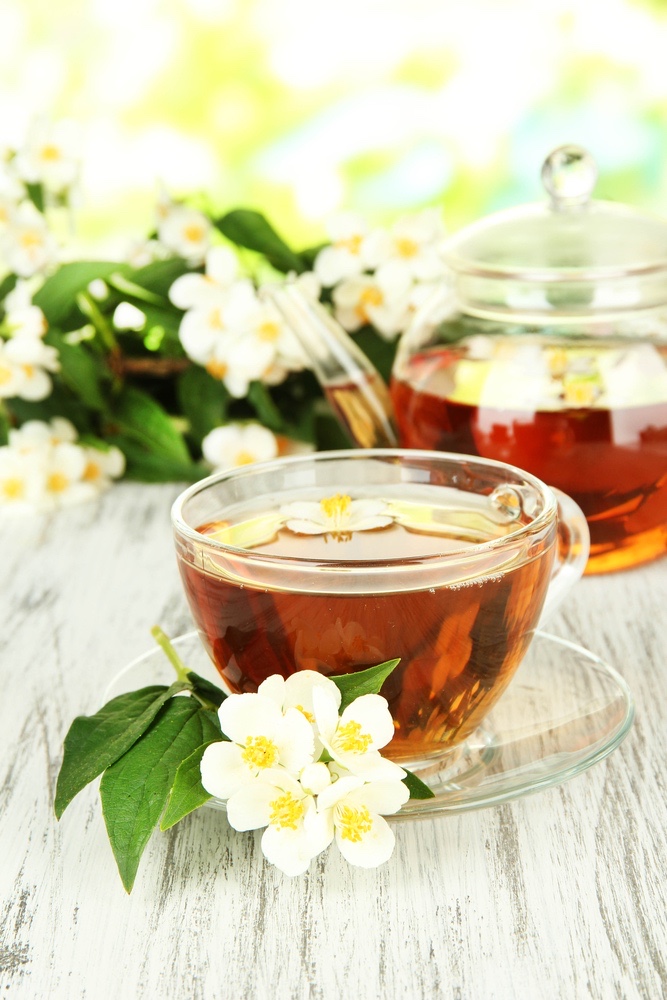
What Does Jasmine Tea Taste Like?
Jasmine tea carries the fragrance of jasmine flowers. In terms of flavor, it is incredibly aromatic, smooth, and delicate, with a tune of honey. Other descriptive words include:
- Fresh
- Refreshing
- Calming
- Flowery
- Sweet, or honey-like
It’s an excellent introduction to tea for beginners. You can still detect some tea flavor, but it’s less pronounced.
However, the distinct flavor profile varies significantly depending on the type.
Green Tea
This is one of the most common types. The fragrant notes of jasmine complement green tea wonderfully! Green tea’s vegetal profile allows the delicate flavors of the flower to shine.
White Tea
White tea is another popular variation. White tea brings up jasmine’s more nuanced tastes. It’s sweeter and somewhat fruitier compared to green tea.
Oolong
This type is a traditional and popular Chinese tea. Jasmine oolong tea imparts a much stronger taste than green tea or white tea. But, it’s slightly milder than black tea. It takes on both vegetal and fruity flavors, which make it very unique and balanced. The oolong base may come off strong, and the jasmine flavor may be difficult to identify.
Black Tea
This is the least common type. Black tea is very robust, strong, and great on its own and might overpower the subtle flavors of jasmine. Regardless, it’s pretty delicious and well worth the try. The floral accents bring out the more soft undertones of black tea.
Milk Tea
Or should we say, boba? Boba, milk tea, bubble tea, or whatever you call it is very popular nowadays. Jasmine milk tea is a popular menu staple, too. Milk tea shops usually use jasmine green tea as their base tea. It’s a sweet, milky, creamy, and fun take on the beverage. A must-try if you’re a sweet tooth. But, don’t drink too much though! It could give you a complete sugar rush or caffeine buzz.
A Selection of the Best Jasmine Tea
If you’re not a veteran Jasmine tea drinker, it may be tricky to know where to start, and what to try, so we’ve put together a list of some of the best brands out there.
We’ve included both bagged and loose-leaf reviews, depending on what you prefer (some avid drinkers of tea will refuse a bag!), and what mood you’re in – if you want a refreshing Jasmine hit on your way to work, or if you just need to sit down and unwind with a full pot of tea and a really good book…
The Best Jasmine Tea in Tea Bags
Mighty Leaf Organic Spring Jasmine

Don’t be deceived by the fact that this tea comes in tea bags, for in every other way it’s as authentic and delicious as it gets. Mighty Leaf’s green tea is scented in the traditional way, by alternately layering the flowers with the dried tea leaves over a period of time to create a strong, lasting aroma. Their elegantly designed (and compostable) tea bags allow whole tea leaves (not sweepings!) the room to unfurl when steeped in hot water.
Mighty Leaf’s tea is the perfect way to begin your Jasmine journey: its aroma is intoxicating, and its flavor is fresh and fulsome. Oh, and to top it all off, it’s also good for the earth. Mighty Leaf produces all USDA certified teas, and are also beginning to develop a line of Fairtrade tea products (though the Jasmine is not yet among them. Perhaps soon). Their Jasmine tea comes in a box of 100 tea bags, and despite quality and ethical/environmental standards, are reasonably affordable.
Rishi Green Jasmine Tea

Rishi Jasmine is also certified organic (and also delicious), though you’ll need to be willing to pay a bit extra. Rishi can also boast of being among the first to earn organic certification under the USDA’s Natural Organic Program in November 2002.
Their company as a strong focus on the ethics and sustainability of tea production and direct trade, involved in supporting growers who cultivate ecologically sustainable gardens in remote locations around the world.
Rishi tea is for the serious Jasmine drinker, with a full-bodied taste and a strong, refreshing aroma.
A minor criticism is the unnecessary over-packaging of the tea bags; for those earth-conscious tea drinkers out there, the Rishi loose-leaf may be a better option.
Comes in a box of 15 tea bags.
The Best Decaf Jasmine Tea
Triple Leaf Decaf Jasmine Green Tea

Being naturally decaffeinated, this tea is a great option for those sensitive to caffeine or as a sleepy tea before bed.
The aroma and flavour are comparable to other caffeinated Jasmine green teas without the possible negative side effects.
If you find that you want to drink tea all day long, then Triple Leaf’s decaf is the way to go. It comes in (very affordable) boxes of twenty bags.
The Best Loose Leaf Jasmine Green Tea
Just as there are coffee snobs, so too are their tea snobs, and for some (regardless of flavor) the tea bag is akin to a spoonful of instant!
So,if you’re determined to watch your green tea leaves and Jasmine blossom sink to the bottom of your favorite tea cup, here are some high-quality loose-leaf brands you might want to try.
Stash Jasmine Tea

Though Stash tea seems far removed from the tea hills of Mount Taimu, brought to life by two hippies in Portland in the 1970s.
Their tea certainly holds its own; it has a lovely aroma and fresh taste, with (in our opinion!) just the right mix of blossom and green tea leaves.
The fact that you can actually see the little white flowers amongst the dried leaves also makes the experience feel a bit more authentic (sitting in your suburban kitchen, you can almost see the rolling tea hills and abundant Jasmine bushes tumbling beside a flowing river).
As well as making great tea, Stash is also recognized as a “B Corp” certified company, which means they look beyond a solely profit-driven approach and are dedicated to improving their social and environmental performance, transparency and accountability.
So basically, your conscience can rest easy!
Stash’s loose-leaf tea also comes in an extra-large box, though it’s slightly more expensive.
The Best Authentic Jasmine
Valley of Tea Yin Hao Silver Tip Jasmine
Valley of Tea’s loose leaf Yin Hao is also a relatively expensive Jasmine, at $18.76 per 100 grams, but their tea is of the highest quality, directly sourced (by a Belgium company) from one of the world’s most famous tea mountains – China’s legendary Mount Taimu, in the Fujian province.
Their Yin Hao is delicate and sweet, with hints of brown sugar, and unlike other bagged Jasmine, can be re-brewed several times without losing flavor or aroma.
Comes in a 100g box of loose-leaf tea.
The Best Jasmine Tea for the Dedicated Drinker
Sunflower Jasmine Tea

Sunflower’s Jasmine green tea is the kind of authentic but affordable variety you might find in your local Chinese restaurant.
It is a flavorsome, traditional-tasting tea and comes in a quaint yellow reusable tin box – and as a bonus for the addicted drinker, there’s a lot of tea in there (at 454 grams).
Compared to other Jasmines, the flower scent is relatively mild, and the tea flavor quite strong.
Like Valley of Teas’ Yin Hao, as a loose leaf, it can be re-brewed around three times before beginning to lose its flavor and aroma.
Final Thoughts on Jasmine Tea
Princesses and queens and fairy-tale cities…is that still tea we’re talking about?
Yes!
For us, there is a unique sense of romance to this age-old Chinese tea: the delicateness, the infusion of night-blooming flowers, the heady scent, and the pull of faraway rivers and mountains.
And of course, the unique, exquisite Jasmine flavor.
We hope you enjoy exploring the world of Jasmine, and we hope romance blossoms.
Happy Sipping!

